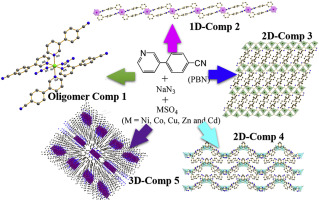Journal of Solid State Chemistry ( IF 3.2 ) Pub Date : 2020-03-21 , DOI: 10.1016/j.jssc.2020.121326 Zhehui Weng , Pengzhi Xiang , Jie Ling , Meixia Huang , Wenfeng Yang , Zhaofa Zheng , Xiujun Deng , Haidong Ju , Yao Huang

|
Five coordination compounds assembled from the pyridyl based ligand, Ni(PBN)4(N3)2, 1; {[Co(PPT)2·(H2O)2]·2H2O}n, 2; [Cu(PPT)]n, 3; {[Zn2(PPT)3(OH)]·2H2O}n, 4, and [Cd(PPT)2]n, 5 (PPT = 5-(3-pyridylphenyl)tetrazole and PBN = 4-(3-pyridyl)benzonitrile) have been solvothermally synthesized and characterized by single-crystal X-ray diffraction, powder XRD, elemental analysis, IR spectroscopy, solid state fluorescence and TG analysis. The PPT ligand in the complexes is generated via the in situ [2 + 3] cycloaddition in the reaction of the cyano groups of the organonitrile and sodium azide. Single-crystal X-ray diffraction analyses reveal compound 1 is an oligomer of 6-coordinated Ni(II) compound where the 6 coordination sites are occupied by six nitrogen atoms from four distinct PBN ligands and two azide ions, respectively. Compound 2 exhibits a 1D chain structure where the 6-coordinated cobalt centers are double connected by two upside down μ2-PPT ligands. Both compound 3 and compound 4 present the 2D sheet structures constructed by μ2-tetrazole-linked copper(I) dimmer and μ2-hydroxy-connected zinc(II) dimmer, respectively, with both centers of 4-coordinated fashions. Compound 5 is a dense 3D framework with the PPT ligand of a μ3-bridging mode. Structural analyses indicate the structural varieties of the dimensionalities in these compounds result from the coordination diversity of the PPT ligands. In addition, compound 3 represents a rare example of copper(II) that is experienced the self-reduction process during the in situ [2 + 3] cycloaddition and exhibits a blue emission at room temperature. Thermal stability analyses indicate the compounds 4 and 5 are stable up to 300 °C and the temperature dependent PXRD reveal the residues of compounds 4 and 5 are ZnO and CdCO3, respectively.
中文翻译:

基于3d金属的一系列新型含吡啶基配合物的原位合成和表征:从低聚物到3D骨架
从基于吡啶基配体组装五种配位化合物,镍(PBN)4(N 3)2,1 ; {[Co(PPT)2 ·(H 2 O)2 ]·2H 2 O} n,2;[Cu(PPT)] n,3 ; {[Zn 2(PPT)3(OH)]·2H 2 O} n,4和[Cd(PPT)2 ] n,5(PPT = 5-(3-吡啶基苯基)四唑和PBN = 4-(3-吡啶基)苄腈)溶剂热合成并通过单晶X射线衍射,粉末XRD,元素分析,IR光谱,固态荧光表征和TG分析。配合物中的PPT配体是通过有机腈和叠氮化钠的氰基反应中的原位[2 + 3]环加成反应生成的。单晶X射线衍射分析表明,化合物1是6位配位的Ni(II)化合物的低聚物,其中6个配位位点分别被来自四个不同的PBN配体和两个叠氮化物离子的六个氮原子占据。化合物2呈现一维链结构,其中6个配位的钴中心通过两个上下颠倒的μ双连接2 -PPT配体。两个化合物3和化合物4本由构建的2D片材结构μ 2 -四唑联铜(I)的调光器和μ 2分别-羟基连接的锌(II)的调光器,具有4配位的时装两个中心。化合物5是具有的PPT配体的致密的三维框架μ 3 -bridging模式。结构分析表明,这些化合物中维数的结构变化是由PPT配体的配位多样性引起的。另外,化合物3代表了一个难得的铜(II)实例,该铜在原位[2 + 3]环加成过程中经历了自还原过程,并且在室温下呈现蓝色发射。热稳定性分析表明,化合物4和5在高达300°C的温度下都稳定,并且温度依赖性PXRD表明化合物4和5的残基分别为ZnO和CdCO 3。









































 京公网安备 11010802027423号
京公网安备 11010802027423号